Physical Address
304 North Cardinal St.
Dorchester Center, MA 02124
Physical Address
304 North Cardinal St.
Dorchester Center, MA 02124
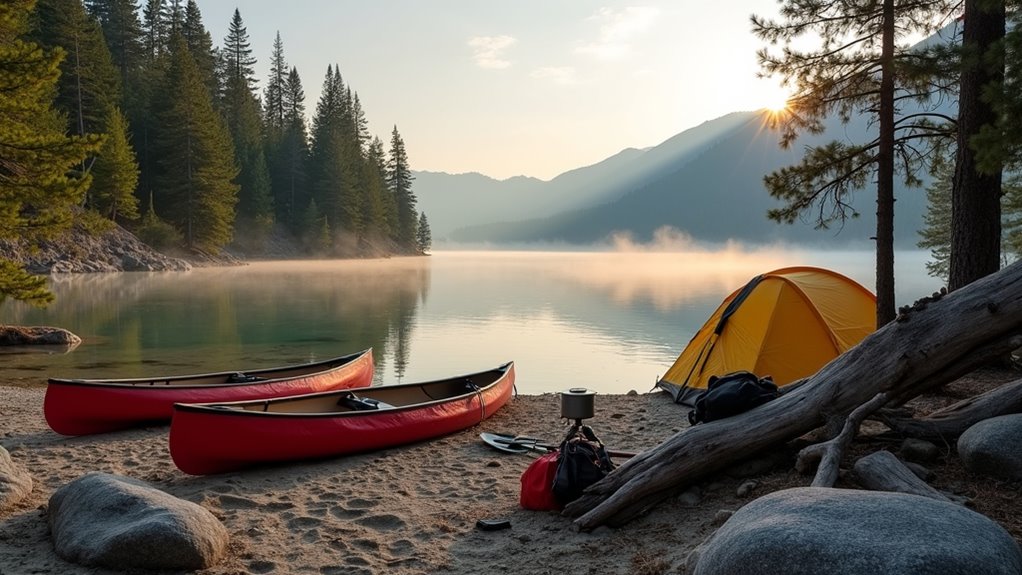
Transform your canoe camping adventures from soggy disasters into wilderness triumphs with these eight essential strategies that beginners absolutely must know.
Last summer, Sarah’s first canoe camping trip turned into a soggy disaster when her sleeping bag got soaked in the first hour. You don’t have to repeat her mistakes. Canoeing camping combines paddling skills with backcountry know-how, but it’s not just about throwing gear in a boat and hoping for the best. There’s a specific art to selecting the right equipment, waterproofing your essentials, and charting remote waterways safely. These eight proven strategies will transform your approach entirely.
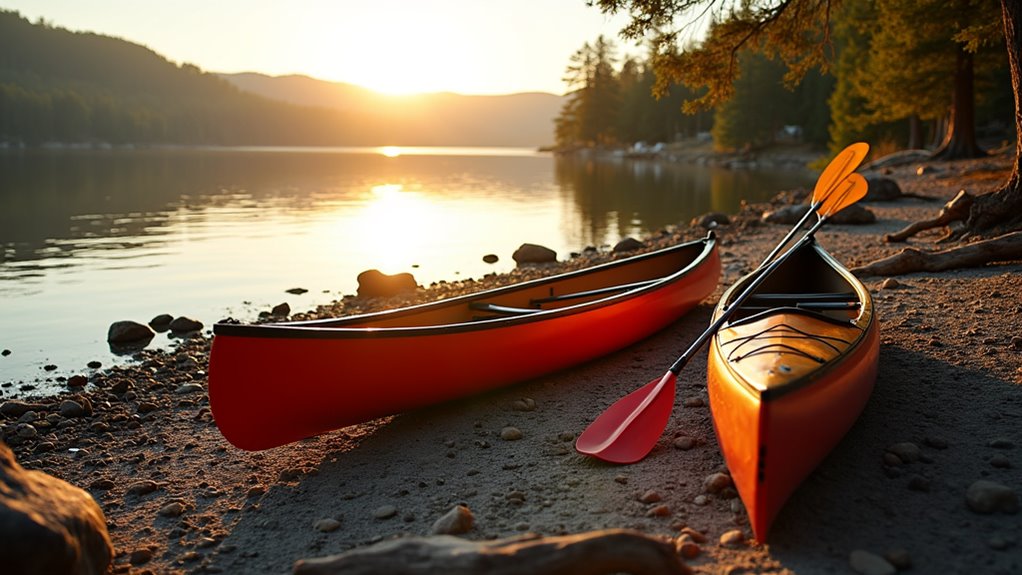
When you’re planning a multi-day canoe camping adventure, your vessel becomes more than just transportation—it’s your lifeline carrying everything you need to survive and thrive in the wilderness. You’ll want a canoe that’s at least 17 feet long with high volume capacity for gear storage.
Aluminum canoes offer durability but create noise that can spook wildlife, while Kevlar models provide lightweight performance at premium prices. Fiberglass strikes the perfect balance for most paddlers.
Don’t overlook your paddle selection. Pack a spare—it’s wilderness insurance you can’t afford to skip. Choose paddles with comfortable grips since you’ll be using them for hours daily. Bent-shaft paddles reduce strain during long stretches, making them ideal for extended trips through backcountry waterways. Consider the paddle’s blade size and shape, as wider blades provide more power per stroke but require greater effort over long distances.
Having the right canoe and paddle won’t matter much if your gear gets soaked on day one. You’ll need multiple layers of waterproof protection, not just one dry bag and crossed fingers.
Start with quality dry bags in various sizes—large ones for sleeping gear and clothes, smaller ones for electronics and first aid supplies. Double-bag critical items like your sleeping bag and spare clothes. Traditional paddlers often use plastic garbage bags as backup liners inside their packs.
Pack heavy items low and centered in your canoe to maintain stability. Distribute weight evenly between bow and stern.
Test your waterproofing system before departing—submerge packed bags in water for thirty minutes. If anything’s damp, you’ve identified weak points before they ruin your trip.
Proper waterproofing also supports low impact camping principles by preventing gear failure that could force you to abandon Leave No Trace practices in emergency situations.
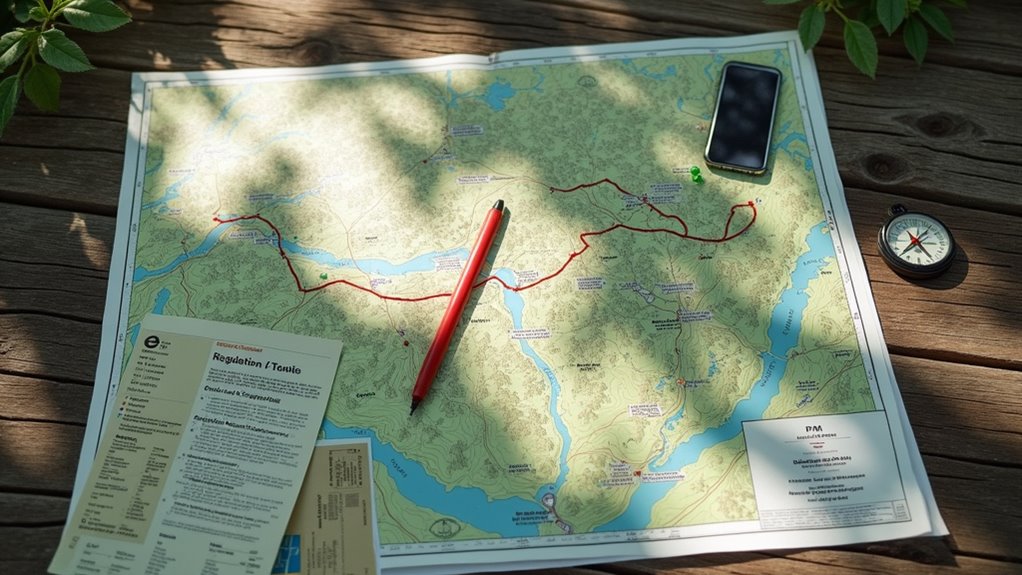
Before you load that perfectly waterproofed gear into your canoe, you’ll need a solid plan for where you’re actually going. Route planning isn’t just about picking pretty spots on a map – it’s about understanding regulations, water conditions, and campsite availability.
Different waterways have vastly different rules. Some require permits months in advance, while others operate on first-come, first-served basis. Research distance between campsites to match your paddling abilities and comfort level.
Essential planning steps include:
If you’re planning a family trip, consider starting with established river rafting routes that offer guided options and kid-friendly amenities.
Proper planning prevents disappointing surprises and guarantees you’re camping legally and safely.
Every ounce matters when you’re paddling miles with your gear, so choosing the right equipment can make or break your canoe camping experience. Prioritize compact, multi-purpose items that nest together efficiently. Your tent should pack small—ultralight backpacking models work perfectly.
Choose a sleeping bag rated for expected temperatures but compressed to softball size. Opt for a lightweight sleeping pad that doubles as back support while paddling.
Pack everything in dry bags or waterproof stuff sacks that fit your canoe’s dimensions. Measure your canoe’s width and depth beforehand to ensure gear fits without affecting stability.
Consider a portaging pack for when you’ll carry gear overland between water bodies. Remember, experienced paddlers often say the best gear is what you don’t bring—pack only essentials.
If you’re new to canoeing, consider whether renting or buying a canoe makes more sense for your first few trips before investing in your own watercraft.
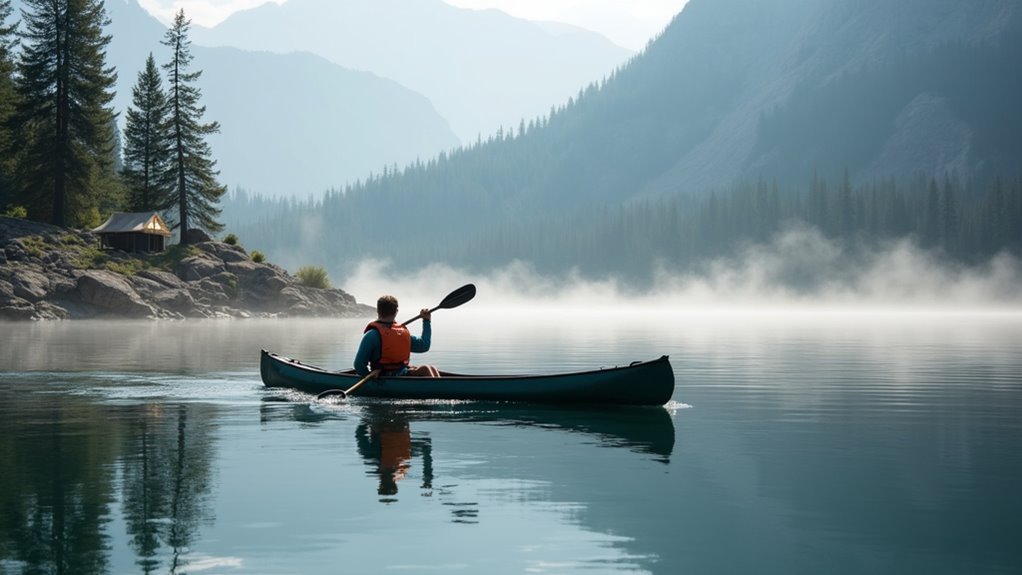
While your gear selection sets you up for comfort, mastering essential paddle techniques and safety skills will determine whether you’ll confidently navigate waterways or struggle against every current.
Start with the forward stroke – reach ahead, immerse the blade fully, and pull through the water beside your canoe. The J-stroke keeps you tracking straight by adding a small steering motion at the end. Practice the draw stroke to move sideways toward docks or campsites.
Essential safety skills you can’t skip:
These fundamentals transform nervous beginners into confident canoe campers. Once you’ve mastered water navigation, you might consider advancing to more challenging adventures like glacier climbing on some of America’s most spectacular frozen terrain.
Paddle skills won’t help you if Mother Nature decides to release her fury while you’re miles from shore. You’ll need to read weather patterns like your grandfather read the morning paper – thoroughly and with respect. Check marine forecasts before launching, but don’t stop there. Watch cloud formations: towering cumulonimbus means thunderstorms ahead. Feel wind shifts – they often signal incoming weather changes.
Water conditions matter equally. Fast-moving water near shorelines indicates strong currents or obstacles. Choppy surfaces suggest wind or underwater disturbances. Morning waters typically offer the calmest conditions, while afternoons bring increased wind and wave activity.
Always have an exit strategy. Identify safe landing spots every mile or so. When conditions deteriorate, experienced paddlers head for shore immediately – pride doesn’t float. Pack perishable foods in a well-insulated cooler with plenty of ice to maintain safe temperatures during your multi-day canoe camping adventure.
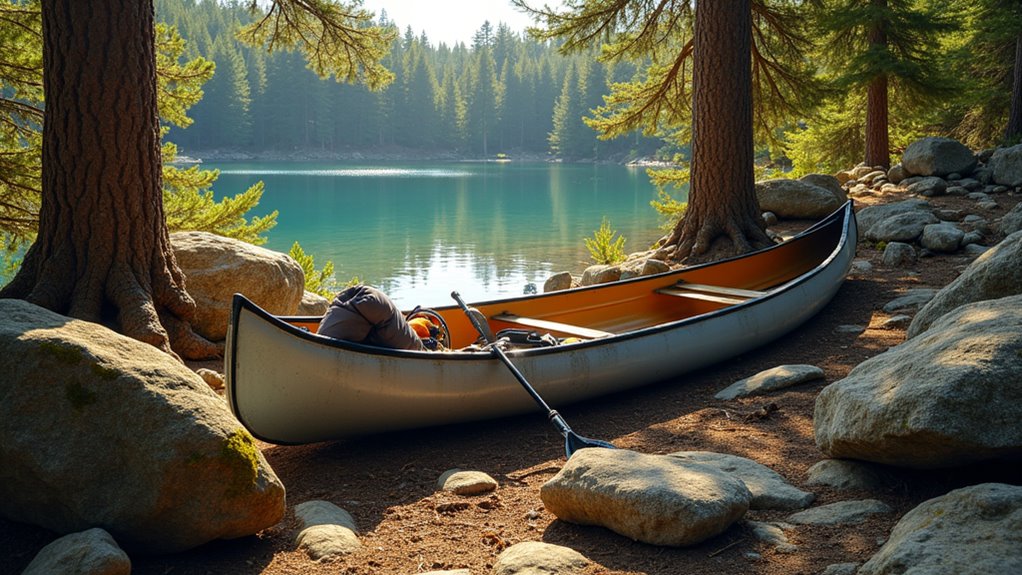
Once you’ve pulled your canoe onto shore, you’ll quickly discover that nature rarely provides perfectly flat campsites. Successfully setting up camp on uneven terrain requires strategic thinking and adaptability. Indigenous paddlers have mastered this art for centuries, using natural features to their advantage rather rather than fighting against them.
Scout your area thoroughly before unpacking everything. Look for the most level spots and consider drainage patterns – you don’t want to wake up in a puddle.
While these techniques work year-round, remember that winter camping presents additional challenges with frozen ground and snow-covered terrain that can mask the true contours of your campsite.
When you’re paddling miles from the nearest road, a minor mishap can quickly escalate into a serious emergency. Your survival depends on preparation and levelheaded decision-making.
Pack an extensive first aid kit with wilderness-specific supplies like splints, water purification tablets, and emergency blankets. Carry multiple communication devices—satellite messenger, whistle, and mirror for signaling. Know how to treat hypothermia, the silent killer on cold waterways.
Create a detailed float plan with someone reliable, including your route, campsites, and expected return.
Practice self-rescue techniques before you need them. Indigenous paddlers traditionally traveled in groups for safety—consider this wisdom seriously.
Most importantly, trust your instincts. If conditions feel dangerous, they probably are. Turn back, make camp early, or wait out bad weather. Pride won’t keep you alive.
Don’t forget to include mosquito repellent in your emergency kit, as these persistent insects can make an already challenging situation unbearable and distract you from critical safety decisions.
You’ve got the blueprint for your maiden canoe camping voyage—now it’s time to trade your Netflix queue for paddle strokes and starlit skies. Remember, every seasoned paddler started as a beginner, so don’t let perfectionism sink your plans. Trust your instincts, respect the water’s power, and embrace the learning curve. Your smartphone can’t capture the peace you’ll find around a crackling campfire after a day of honest paddling. Adventure’s calling—answer it.